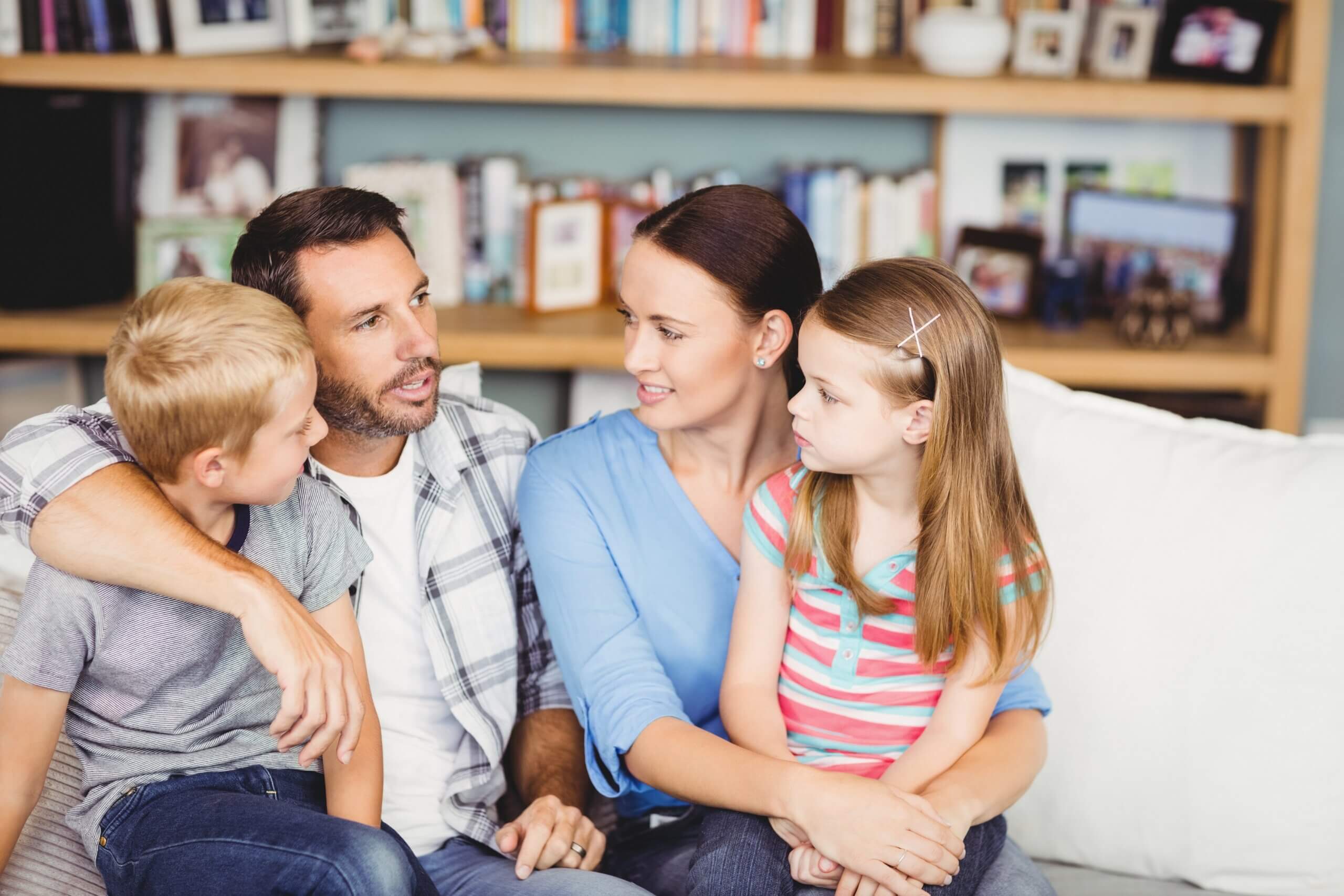5 Keys to Encourage Reflection in Children


Written and verified by the psychologist Maria Fátima Seppi Vinuales
Children tend to see the world through curiosity and exploration. Generally, they wonder about things that we adults naturalize and take for granted. However, sharing with them is an excellent opportunity to look at everything with eyes of wonder, to be enriched by their ideas, and also to encourage reflection in children as a habit. Let’s see how to do it and what its benefits are.
Why do we want to encourage reflection in children?
There’s no doubt that encouraging reflection in children has great benefits, but above all, we give them the opportunity to become agents and protagonists of their own learning.
At the same time, it’s also very important to strengthen the relationship between the different agents involved in the education of children. In other words, it can’t be the exclusive responsibility of the family or the school. The more all parties share this work, the better it will be for children. These are some of the many benefits of encouraging reflection in children.
- It allows them to generate critical thinking.
- It contributes to developing empathy and understanding situations from multiple points of view.
- It helps them to establish relationships between different situations.
- It contributes to the development of imagination.
- Encouraging reflection helps in impulse control: If we teach them to reflect, they’ll have more tools to do so before acting.
You may be interested in: Self-Reflection in Education: Important Steps
5 ways to encourage reflection in children
It’s very important for reflection to become a daily occurrence at home, even if it’s just for a few minutes a day. It doesn’t have to be something very organized or structured, but it does have to be constant. We can also use different elements to help stimulate reflection, for example, using a story or a song as a trigger. In addition, it’s key to stop separating intelligence from emotional intelligence.
In this sense, it’s also about getting to know the children and identifying the most appropriate learning strategy for them. Some will have better thinking skills when some visual support is used, while others prefer to do it through music. Also, it’s always advisable to take into account their age.
Here are some of the ways to encourage reflection in children:

1. Help them to relate situations
When the child asks or tells something about an event, it’s good to help them to relate it to other situations. To do this, we can invite them to use examples when explaining something.
2. Teach them the meaning of words
When the child uses certain words or objects, you can ask them to explain if they know what they mean and what the words are used for. For example, if he says the word “vehicle,” you can ask him what it’s used for. This way, you help them think of the many situations for which it can be used, such as going on a trip to grandma’s, getting to work, or taking pets to the vet, among others.
3. Guide the child with questions
Guiding the child with questions will allow them to think about different scenarios and emotions. For example, reflection in children can also go hand in hand with the development of empathy. So, some questions we can ask them are the following: How would you feel if that happened to you, why do you think that person acts that way, do you think you could do something about it, or what would you do in their place?
4. Suggest different activities
Developing creativity allows children to find multiple paths and ways to reach different outcomes. It also teaches them that beyond the four walls of the home, there’s another world. And the more they get to know it, the more they’re enriched.
Then, you can suggest different activities, such as playing games, making crafts, dancing, singing, or playing sports. This will allow them to get to know other things and not take anything for granted.

5. Create spaces for dialogue
Creating spaces for dialogue and debate in your family also helps children develop their capacity for reflection. According to their age, you can suggest a topic on which each one should express their opinion or what they think about it. In addition, the aspects for and against should be raised. These can be current topics, some that are trending on social networks, or more general ones, such as what music they like the most.
You may be interested in: The Connecting Corner as an Alternative to the Reflection Corner
Teach that there are multiple answers
When we encourage reflection in children, what we do is to show them the multiple faces of reality. This way, they learn that there are many ways of being and living and that we’re not all in the same conditions. This way, they come to understand that there’s no absolute truth and that there are multiple ways of understanding a situation or approaching a problem. In any case, it’s always important to guide them on values and respect.
We also encourage autonomous thinking so that they’re not like soldiers or robots who repeat what others or even their parents do. This way, they learn that they’re capable of thinking for themselves.
Children tend to see the world through curiosity and exploration. Generally, they wonder about things that we adults naturalize and take for granted. However, sharing with them is an excellent opportunity to look at everything with eyes of wonder, to be enriched by their ideas, and also to encourage reflection in children as a habit. Let’s see how to do it and what its benefits are.
Why do we want to encourage reflection in children?
There’s no doubt that encouraging reflection in children has great benefits, but above all, we give them the opportunity to become agents and protagonists of their own learning.
At the same time, it’s also very important to strengthen the relationship between the different agents involved in the education of children. In other words, it can’t be the exclusive responsibility of the family or the school. The more all parties share this work, the better it will be for children. These are some of the many benefits of encouraging reflection in children.
- It allows them to generate critical thinking.
- It contributes to developing empathy and understanding situations from multiple points of view.
- It helps them to establish relationships between different situations.
- It contributes to the development of imagination.
- Encouraging reflection helps in impulse control: If we teach them to reflect, they’ll have more tools to do so before acting.
You may be interested in: Self-Reflection in Education: Important Steps
5 ways to encourage reflection in children
It’s very important for reflection to become a daily occurrence at home, even if it’s just for a few minutes a day. It doesn’t have to be something very organized or structured, but it does have to be constant. We can also use different elements to help stimulate reflection, for example, using a story or a song as a trigger. In addition, it’s key to stop separating intelligence from emotional intelligence.
In this sense, it’s also about getting to know the children and identifying the most appropriate learning strategy for them. Some will have better thinking skills when some visual support is used, while others prefer to do it through music. Also, it’s always advisable to take into account their age.
Here are some of the ways to encourage reflection in children:

1. Help them to relate situations
When the child asks or tells something about an event, it’s good to help them to relate it to other situations. To do this, we can invite them to use examples when explaining something.
2. Teach them the meaning of words
When the child uses certain words or objects, you can ask them to explain if they know what they mean and what the words are used for. For example, if he says the word “vehicle,” you can ask him what it’s used for. This way, you help them think of the many situations for which it can be used, such as going on a trip to grandma’s, getting to work, or taking pets to the vet, among others.
3. Guide the child with questions
Guiding the child with questions will allow them to think about different scenarios and emotions. For example, reflection in children can also go hand in hand with the development of empathy. So, some questions we can ask them are the following: How would you feel if that happened to you, why do you think that person acts that way, do you think you could do something about it, or what would you do in their place?
4. Suggest different activities
Developing creativity allows children to find multiple paths and ways to reach different outcomes. It also teaches them that beyond the four walls of the home, there’s another world. And the more they get to know it, the more they’re enriched.
Then, you can suggest different activities, such as playing games, making crafts, dancing, singing, or playing sports. This will allow them to get to know other things and not take anything for granted.

5. Create spaces for dialogue
Creating spaces for dialogue and debate in your family also helps children develop their capacity for reflection. According to their age, you can suggest a topic on which each one should express their opinion or what they think about it. In addition, the aspects for and against should be raised. These can be current topics, some that are trending on social networks, or more general ones, such as what music they like the most.
You may be interested in: The Connecting Corner as an Alternative to the Reflection Corner
Teach that there are multiple answers
When we encourage reflection in children, what we do is to show them the multiple faces of reality. This way, they learn that there are many ways of being and living and that we’re not all in the same conditions. This way, they come to understand that there’s no absolute truth and that there are multiple ways of understanding a situation or approaching a problem. In any case, it’s always important to guide them on values and respect.
We also encourage autonomous thinking so that they’re not like soldiers or robots who repeat what others or even their parents do. This way, they learn that they’re capable of thinking for themselves.
All cited sources were thoroughly reviewed by our team to ensure their quality, reliability, currency, and validity. The bibliography of this article was considered reliable and of academic or scientific accuracy.
- Razeto, A. (2016). El involucramiento de las familias en la educación de los niños: Cuatro reflexiones para fortalecer la relación entre familias y escuelas. Páginas de educación, 9(2), 184-201.
- Bedoya, M. N. (1990). El juego como recurso didáctico:: una reflexión educativa. Tabanque: Revista Pedagógica, (6), 113-122.
This text is provided for informational purposes only and does not replace consultation with a professional. If in doubt, consult your specialist.








